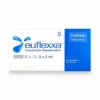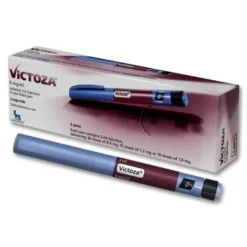Saxenda -3 Pens
$150.00
- Week 1 – 0.6mg dose once daily
- Week 2 – 1.2mg dose once daily
- Week 3 – 1.8mg dose once daily
- Week 4 – 2.4mg dose once daily
- Week 5 – 3.0mg dose once daily continuing
What is Saxenda?
Saxenda is an injection used for weight loss. It contains the medicine liraglutide. It can be used alongside diet and exercise to help aid weight loss. The Saxenda pen is a registered trademark of Novo Nordisk.
The drug can be prescribed for people with a body mass index (BMI) over 30. It can also be used for people with a BMI over 27 who have also been diagnosed with weight-related medical problems. These include:
- Pre-diabetes and diabetes type 2
- Hypertension (high blood pressure)
- High cholesterol
- Obstructive sleep apnoea
How does Saxenda work?
Saxenda contains the active ingredient liraglutide. Liraglutide is similar to a hormone in the body called glucagon-like peptide-1 (GLP-1). This is an appetite hormone that helps regulate hunger and is released by the intestines after a meal.
Due to being similar to GLP-1, Saxenda regulates appetite causing you to feel fuller and less hungry. This can lead to eating fewer calories and losing weight. Focussing on eating a reduced-calorie diet will further enhance the benefits of Saxenda.
Is it for me?
Saxenda should only be used to help with weight loss if you have already tried and failed to lose weight through exercise and diet alone.
Certain patients can not use Saxenda. You should also avoid Saxenda if:
- You have an allergy to the active ingredient, liraglutide or any of the ingredients in Saxenda
- You are pregnant or plan to become pregnant. Saxenda can harm your unborn baby.
- You are breastfeeding
How effective is it?
When using Saxenda pens to suppress appetite, you can expect to lose a minimum of 5% of your initial body weight after completing a 12-week course of treatment. You should stop using Saxenda if you have been unable to lose at least 5% of your starting body weight at this time.
In clinical trials of Saxenda, patients saw better results in losing weight when compared to using a placebo injection over 56 weeks. The results are summarised below;
- 63% lost at least 5% of body weight
- 33% lost at least 10% of body weight
- 15% lost at least 15% of body weight
SAXENDA
Saxenda comes as an injectable pen. The Saxenda pen is injected once daily subcutaneously. The usual injection sites will be the upper arm, upper thigh or abdomen.
The starting dose is a daily injection of 0.6mg. This dose is increased at intervals of usually 1 week until a dose of 3.0mg once daily is reached. An example schedule is shown below:
- Week 1 – 0.6mg dose once daily
- Week 2 – 1.2mg dose once daily
- Week 3 – 1.8mg dose once daily
- Week 4 – 2.4mg dose once daily
- Week 5 – 3.0mg dose once daily continuing
The dose is gradually increased in 1-week intervals to reduce the chances of stomach side effects like nausea, vomiting and diarrhoea.
If you increase the dose and find the side effects problematic for two weeks or more you should discuss this with your doctor or pharmacist.
Side effects
The most common side effects with Saxenda affect the digestive system: nausea, vomiting, diarrhoea and constipation. These should subside after a few days or weeks.
Other common side effects include:
- Feeling weak or tired
- Dizziness
- Insomnia
- Injection site reactions such as bruising, pain or a rash
Another side effect can be hypoglycaemia. This is the medical name for low blood sugar. This is more likely to be a side effect for patients who have type 2 diabetes but can happen in other patients. The signs of low blood sugar are: cold sweat, pale skin, headache, fast heartbeat, feeling sleepy or weak, feeling nervous and difficulty concentrating, among other symptoms.
An uncommon side effect is pancreatitis. This is a serious and potentially life-threatening illness. Symptoms include severe, persistent pain in the abdomen and nausea and vomiting. If you have these symptoms stop using Saxenda and contact your doctor immediately.
Please report any side effects to your doctor or pharmacist.
Be the first to review “Saxenda -3 Pens” Cancel reply
You must be logged in to post a review.
Related products
Weight Loss
Weight Loss
Weight Loss
Weight Loss
Weight Loss
Weight Loss
Weight Loss













Reviews
There are no reviews yet.